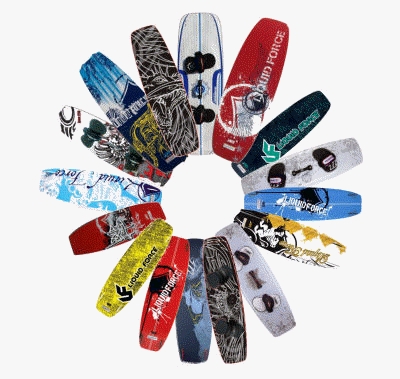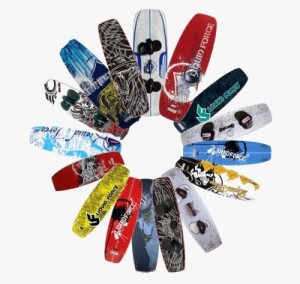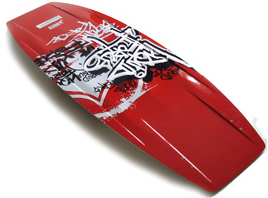

A question I get asked all the time is which board should I buy first? I’ve put together the following article to try to help some of you guys out and hopefully give you some insight as to what you should be looking for.
The most important thing to look for as a beginner when buying a board is the size. By size I mean the length and width of the board. Generally speaking the larger the board the easier it will be to learn on as it offers several advantages to the beginner kitesurfer. The most important of these advantages is buoyancy. Because of its larger surface area a larger board has a great deal more buoyancy than a smaller board. This makes it easier for the rider to stay on the plane (riding above the water) but also means that if the wind dies or the power from the kite drops (possibly due to a beginners under developed kite handling skills) the board will stay on top of the water and you, the rider, will not experience that unpleasant but wonderfully named “tea bagging” sensation. The increased buoyancy also means that the rider does not need as much power through the kite to be able to ride which means that the beginner can take out a smaller kite than they other wise might have to. At the early stages this really helps to grow your confidence and improve your kite skills.
The main disadvantages associated with a large board are mainly to do with feel, a large board feels…well, large! It is unresponsive and doesn’t feel very dynamic, it has a habit of getting caught in chop and at high speeds can become unstable as it bounces over the chop (as opposed to slicing through it). When you jump and start doing ariel moves you will really notice the added weight and while good for your abs isn’t necessarily good for your technique. Due to these reasons most people will quickly look to buy a smaller board as they become better riders.
This brings us to the main issue with buying a large board…you will, relatively quickly, out grow it. How quickly depends on how much practice you get, but I would suggest as soon as you start going airborne you’ll want to look for something smaller. People take many different approaches to this. Some people buy a large board for learning on and then upgrade to a smaller board when they are ready. The larger board can then be sold or used as a light wind board. Due to the buoyancy mentioned earlier a large board needs less wind to get going and so will get you up and riding on days when it’s simply not possible on a small board. Many people however simply opt to buy an intermediate board straight away and deal with it in the early stages knowing that it will last them years once they can handle it. I would mention however that an often unspoken advantage of owning 2 boards with vastly different buoyancy is that it can reduce the amount you need to spend on kites (which are typically more expensive and easier to break) by increasing the wind range of your current quiver. Lets say you own 2 kites an 8 and a 12 m and 1 135cm board. Your wind range with both kites and the board might be from 14 to 28 kts (depending on your size and ability) If you bought a large 150 cm board the upper end of the wind range might go up to 33 kts meaning that you get out more days, it may also mean than you can change your kite sizes to a 7m and a 13m because you have increased the wind range of both kites and so now go out in anything from 12 to 35 kts. (these numbers have just been plucked from my head to illustrate the point and have no actual basis in reality before anyone comments!) If you were wanting to cover this wind range using just your 135 cm board you would probably need to buy another kite somewhere in the 10m mark. Kites cost a lot more than boards and lose their value much more quickly.
Whether you decide to do this or not will depend very much on your own personal style and preference. Some people love to have the exact right kite up for any given day, if this is you I’d plumb for the 3 kite quiver option, if you’re not so fussy then having 2 kites and 2 boards can get you out just as often for a lot less cash.
So how big is big enough for the beginner kitesurfer. I would generally say a big board is something anywhere between 140 cm up to 160 cm. Any bigger than this and you might as well ride a canoe…anything smaller and you’re getting in to small board territory. The bigger and heavier you are the larger the board you’ll want within this range. So for example for a small girl a large board would be a 140, whereas for a 6’4″ bodybuilding bloke a 160 would probably be nearer the mark. There is no perfect size and it’ll vary for everyone so don’t worry over whether you should buy a 145 or a 146 cm board, just get out there. After a session or two the experience you’ve gained will more than compensate for the cm’s of difference.
Finally I should mention a few other things which can make your experience as a beginner all the more pleasant. Fins have a hinge impact on the boards performance…if you don’t believe me just try riding your board without any and feel the difference for yourself. Larger fins will generally give you a more stable feel and drive you upwind harder. For these reasons I always recommend to go for fins that are at least 5 cm. Again once your comfortable have a play around with the fin size it’s a real fun way to change your riding style without spending too much money.
Pads and straps simply need to fit and be comfortable. They should be tight enough that you’re board is not going to fly off while you’re riding but loose enough that you can kick the board off if you have one of those oh s**t moments. Most important is that they are comfy, with no sharp edges or bits that will rub at your tender tootsies.
Last but not least is the handle, as a beginner make sure you get a board with a handle. It really does make the whole experience of getting the board on your feet, or even picking the board up from the beach much easier.
Hopefully that makes things a bit clearer for you but if you’ve got any questions let me know in the comments and I’ll get back to you asap.



